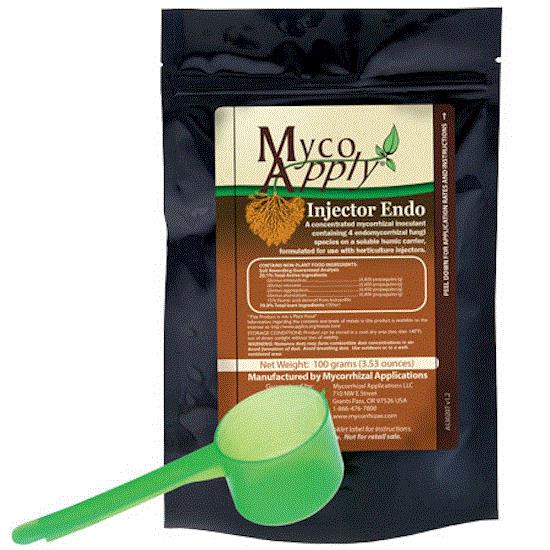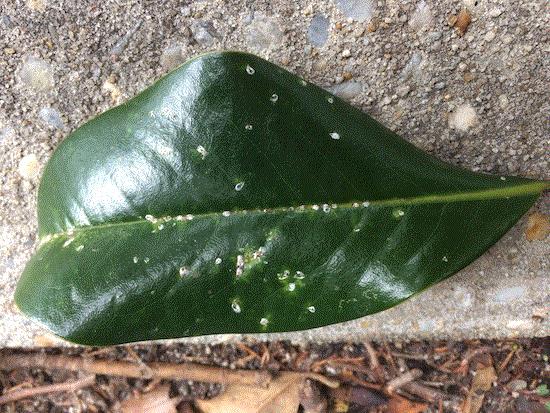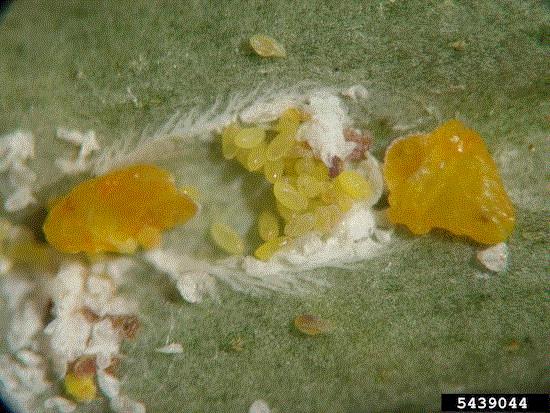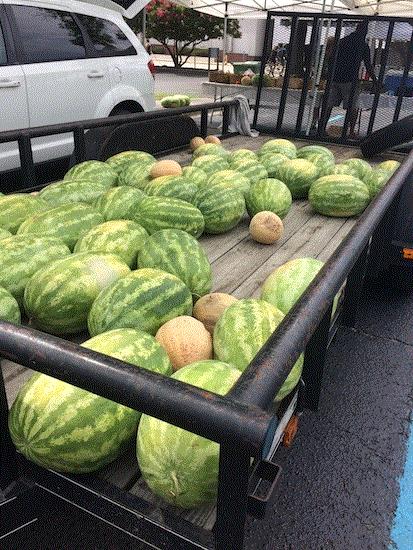OHP updates Pedestal
Pedestal, which contains novaluron (an insect growth regulator in IRAC Group 15), has a new look, new EPA registration number and new product code. It’s available in all states, except California, where registration is pending.
I remember the introduction of Pedestal when I was a wee graduate student. Chemtura marketed Pedestal at that time. My major advisor, Ron Oetting at the University of Georgia, showed that this product was quite effective against whiteflies and thrips. The insecticide is now available in OHP packaging. The new label is much the same as the old label. It’s registered for management of caterpillars, leafminers, thrips, whiteflies, and plant and lygus bugs on ornamentals in greenhouses and nurseries, and on tomatoes in greenhouses. Since it’s an insect growth regulator, Pedestal only has effects against immature stages. The REI is 12 hours.

MA introduces MycoApply Injector Endo
Mycorrhizal Applications (MA), a Grants Pass, Oregon-based company has introduced MycoApply Injector Endo, a new addition to its MycoApply line of products. Different from other MycoApply formulations, the new product is a highly concentrated formulation with a humic acid carrier and can be applied through injection dosing systems. The new product is available in all states, except California.
This new product contains the same four species of Glomus endomycorrhizal fungi—G. intraradices, G. mosseae, G. aggregatum and G. etunicatum—as others in the MycoApply line of products. MycoApply Injector Endo is sold in 100-gram bags. A 20-gram scoop is included in the packaging so that you can accurately measure 20 grams for each gallon of water in the injector stock tank. Each gram of product delivers about 17,600 propagules. The stock solution is diluted to 1:100 and delivered as a drench to plants via the injector system, boom sprayer, sprinkler system, tray dip, or drip irrigation. This new product has a shelf-life of two years.

Blair Busenbark, MA’s Sales and Commercial Marketing Manager, wrote that the new product has its genesis in a need from large growers to apply a highly concentrated mycorrhizal product as a drench via an injection dosing system. To solve the problem of clay residue in the injector tank (as may happen when using MycoApply Untrafine Endo), avoid the need for constant agitation, and produce a more soluble product, MA developed the humic acid carrier for MycoApply Injector Endo.
Find more information about MycoApply Injector Endo, including drench and boom spray application recommendations, by clicking here.

False oleander scale is wreaking havoc
I received several calls about white, oyster-shaped armored scales on southern magnolias in the past few weeks. In most cases, those scale insects turned out to be the false oleander scale, or what some call the magnolia white scale. To-may-to, to-mah-to— they are the same species. Pseudaulacaspis cockerelli has seven different common names, depending on where you come from and its most common host plant at a specific location.
At last count, the false oleander scale feeds on more than 260 plant species from 79 families. In South Carolina, I find this armored scale most frequently on southern magnolias, sweetbay magnolias, cycads, oleanders and palms. This species is part of a quartet of major pests of southern magnolias in southern landscapes and nurseries. (The other members of the quartet are magnolia scale (a soft scale), algal leaf spot and black twig borer.) The scales feed on the upper surface of southern magnolia leaves, but on cycads, they feed on the underside of the fronds. Feeding causes leaf chlorosis, or yellowing.
Y’all can tell the false oleander scale apart from other armored scale relatively easily. The cover of a female is about 2 to 3 mm. long, flat, and pear-shaped with a small yellow or brown cover at the tip of the white cover. When a cover is flipped over with a pin, the female body, eggs and crawlers are yellow underneath. The female body is smaller on one end (head and thorax), and larger and with lobes on another (abdomen).


False oleander scale infestation on a southern magnolia leaf. When the scale covers are removed, the bodies of females and eggs are plainly visible. (Photo credit: Top, JC Chong; Bottom, Chazz Hesselein, formerly Auburn University; bugwood.org.)
As common and important as the false oleander scale is, we don't know much about its biology. It might have originated from China, but no one knows for sure. It was first found in Florida in 1942, but it’s now distributed in the southern United States from Virginia through Missouri to California. Ham Tippins, a professor at the University of Georgia and a renowned scale insect scientist, reported in 1968 that the false oleander scale reproduced year-round in southern Georgia, and each generation was completed within two months. In coastal South Carolina, I’ve found at least four generations, and crawlers are present at any time of the year. No effective biological control agent is known.
So, here is what we know: females produce eggs for 60 days and crawlers are present at all times. These two facts pose significant challenges for management. One foliar application will not completely eliminate the population because reproducing adults and older nymphs that aren’t killed by the insecticides will always be there and propagate the population. Multiple foliar applications will be needed to do the job.
I conducted a field trial in 2010 (with funding from the IR-4 Project) and found that two applications (21 days apart) of Distance (pyriproxyfen; application rate at 12 fl. oz. per 100 gallons), Talus (buprofezin; 14 oz. per 100 gallons) and horticultural oil (2%) reduced the scale insect population on southern magnolias by 85%. Multiple sprays per year over several years are often needed to reduce the population.
A longer term solution, particularly on tall, mature trees, may require soil drenches of systemic insecticides. In a separate trial conducted in 2010 (also with support from the IR-4 Project), I found that one soil drench application with Safari 20SG (dinotefuran; 6 grams per inch diameter at breast height or d.b.h.) could reduce the scale population on mature magnolias by 90% within six weeks of treatment, and by 98% within one year of the initial treatment. Other systemic insecticides worked slower than Safari. At one year after the initial treatment, mortality of the scale insect population was 84% with one granular application of Safari 2G (dinotefuran; 60 grams per inch d.b.h.); 71% with one soil drench of Flagship 25WG (thiamethoxam; 4 grams per inch d.b.h.); 81% with one granular application of Flagship 0.22G (thiamethoxam; 454 grams per inch d.b.h.); 64% with one soil drench of Arena 50WDG (clothianidin; 4.8 grams per inch d.b.h.); and 63% with two foliar applications (17 days apart) of Tristar 30SG (acetamiprid; at 8 oz. per 100 gallons). Because one soil drench application of systemic insecticides does not eliminate the population, one yearly application in the spring will be required until the scale population is no longer an issue.
I haven't done much to look at other systemic insecticides, such as the diamides (Acelepryn and Mainspring) and the tetramic acid derivatives (Kontos), since 2010. These new products may be necessary down the road since they’re replacing neonicotinoids for some operations. We don't know how application of systemic insecticides can impact pollinators (such as bumble bees) that visit southern magnolia blooms.
Much is still need to be learnt.

Local watermelons = summer
My summer isn’t marked on the calendar, or indicated by the thermometer. To me, nothing says “summer is here” as loudly as watermelons from Mr. Ellerbe, available from our downtown farmers market. I’ve enjoyed them since the first week of June. I hope you’re having your watermelon feast!

Consider completing IR-4’s Biennial Grower and Extension Survey while you’re enjoying your watermelons. I know, I know, not another survey. But, this survey will help the IR-4 Project prioritize how to spend its $500K budgeted for research in 2020 and 2021. If you have any particular pest issue that is really bugging you, tell us via the survey so that resources can be allocated to solving your problem. It took me about eight minutes to complete the survey. Results of the survey will be posted on the IR-4 website after September.
Cultivate is here! I’ll be joining the folks of BASF at their booth for cocktail hour on Monday, 4 to 5 p.m. Bring me your bugs and questions, or just come out to wet your whistle.





See y'all at Cultivate!

JC Chong
Associate Professor of Entomology at Clemson University
This e-mail received by 25,155 subscribers like you!
If you're interested in advertising on PestTalks contact Kim Brown ASAP!